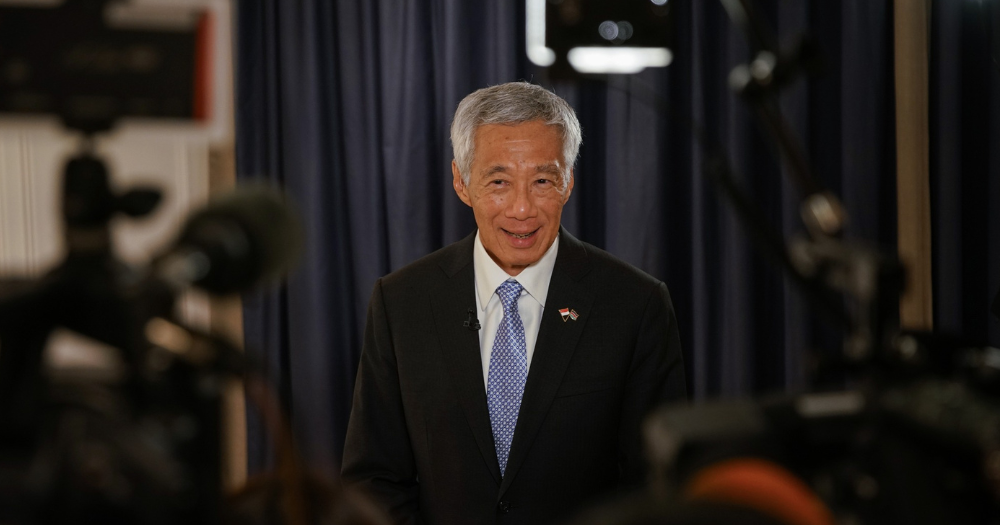Prime Minister Lee Hsien Loong, Singapore's third prime minister, is stepping down after 20 years in office.
He will be handing over the reins to his successor, Deputy Prime Minister (DPM) Lawrence Wong on May 15, 2024.
During his time as Singapore's PM, PM Lee oversaw major crises such as the country's worst ever recession and a global pandemic, as well as major projects like the expansion of the Marina Bay Area, which have transformed Singapore's skyline.
Here's a look back at some milestones during his time as PM:
First National Day Rally
Prior to becoming PM, Lee served as then-PM Goh Chok Tong's DPM for 14 years.
He succeeded Goh as prime minister on Aug. 12, 2004.
One highlight of PM Lee's first National Day Rally speech in 2004 was the announcement of an official five-day work week, removing the half-working day on Saturday.
He also announced that maternity leave in Singapore would be increased from eight to 12 weeks.
Integrated resorts
In 2005, PM Lee's government proposed for two Integrated Resorts to be built in Marina Bay and Sentosa.
This marked the first time casino gambling was legalised in Singapore, sparking controversy and arousing concerns about potential negative social impact.
The intention was to "reinvent Singapore" with an "anchor attraction" in order to boost tourism revenue and investment, PM Lee explained in Parliament.
Under his watch, the Marina Bay area was further developed into a financial hub in tandem with other attractions like Gardens by the Bay that have become an iconic part of the Singapore landscape.
Recession
A few years later, Singapore was badly hit by the 2008-2009 global financial crisis.
Heavily dependant on exports, it was the first country in East Asia to succumb to recession, which brought retrenchments, wage cuts and hiring freezes.
Under PM Lee's charge, the government pledged S$2.9 billion in November 2008, and a further S$20.5 billion in January 2009 to help Singapore workers and businesses cope.
In August 2009, PM Lee announced that “the worst is over for the Singapore economy” and that “the eye of the storm has passed”.
The economy saw a swift rebound in 2010.
Policies for a future Singapore
Singaporeans would get a glimpse of what PM Lee meant at his swearing-in, when he promised a "fresh and bold approach" to policies that would take Singapore forward and "unite all Singaporeans".
In 2013, MediShield Life was implemented to provide universal and lifelong health insurance coverage for all Singaporeans.
PM Lee also launched the Smart Nation initiative in 2014, resulting in the likes of 2015's National Steps Challenge, roadmaps for electronic payments and smarter HDB infrastructure.
And to support Singaporeans in embracing lifelong learning and skills, PM Lee pushed heavily for the SkillsFuture scheme, which launched in 2016.
Policy shifts during PM Lee's time in office also accounted for the changing attitudes among the electorate.
For instance, the controversial Section 377A – a colonial-era law that banned sex between men – was repealed in 2022, after years of debate between different sections of society.
Covid-19
PM Lee's last few years in office will likely be remembered for two words: the pandemic.
In April 2020, with Covid-19 cases ballooning, PM Lee declared an unprecedented "circuit-breaker" — involving wide ranging public health restrictions — to halt the spread of the virus.
He served as an advisor to the Multi-Ministry Taskforce, co-chaired by Wong, his successor, to steer Singapore through the pandemic.
And hundreds of thousands of people in Singapore would tune in to hear PM Lee communicate updates about the highly fluid situation, announcements about Covid-19 restrictions, and rally citizens during the crisis.
It would be nearly two years of battling Covid-19 later, with the government having spent more than S$100 billion on stimulus packages, that PM Lee could finally assure Singaporeans that they were on "the path to a new normal", in a March 2022 speech.
Then, he was already 70, the age by which he previously said he would have liked to step down as PM.
Succession
PM Lee's succession plans, however, were far from smooth.
In 2018, he had initially tipped Deputy Prime Minister Heng Swee Keat to lead the 4G team.
But in April 2021, Heng, who turned 60 that year, told PM Lee of his intention to step aside from the role. He cited his age and a stroke he suffered in 2016 as reasons for his decision.
Amidst the uncertainty that followed, the 4G team requested PM Lee to stay on as prime minister until they could choose a new leader.
Eventually, Wong was selected as the new leader of the 4G ministerial team in April 2022.
And on Nov. 5, 2023, PM Lee officially announced that he would be handing over leadership to Wong before the next General Election.
"Lawrence has told me that he is ready," he said. "I have full confidence in Lawrence and his team and there is no reason to delay the political transition."
'Work with them to create a brighter future for S'pore'
PM Lee called on Singaporeans to support Wong and his team in a Facebook post on Apr. 15.
PM Lee wrote:
"For any country, a leadership transition is a significant moment. Lawrence and the 4G team have worked hard to gain the people’s trust, notably during the pandemic. Through the Forward Singapore exercise, they have worked with many Singaporeans to refresh our social compact and develop the national agenda for a new generation."
He added that the 4G team leaders are committed to keeping Singapore working well and moving ahead, saying that these goals "will always be top priorities for the government".
"I ask all Singaporeans to give Lawrence and his team your full support, and work with them to create a brighter future for Singapore," PM Lee wrote.
Related articles:
Top image from Terence Tan / MCI.

If you like what you read, follow us on Facebook, Instagram, Twitter and Telegram to get the latest updates.



